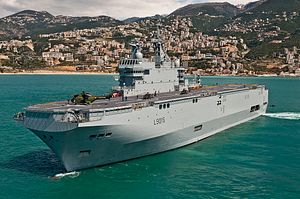Has the saga of the Russian Mistrals finally entered its next chapter?
Reports earlier this week indicated that France had lined up a deal to sell the two amphibious assault ships to the Egyptian government. Rumors suggest that Gulf states, and in particular the United Arab Emirates, helped finance the deal. Assuming that the ships remain in Egypt and aren’t flipped to Russia (or another destination) in the next few years, the sale has a few implications for maritime affairs in East Asia.
First, the ships apparently won’t end up in Asia, where the Mistrals could have contributed to maritime security, disaster relief, and active military operations. One of the more plausible reports regarding their eventual disposition involved Malaysia, one of the limited number of countries with sufficient interest and financial wherewithal to make a deal happen. Given the stronger defense cooperation between France and India in recent years, the Indian Navy also represented a potential target.
The direct impact on Asia comes in the form of enhanced regional stability. Mistrals, assuming they are well-maintained, will give the Egyptian Navy the ability to monitor and manage its littoral in both the Red Sea and the Mediterranean. This will enhance maritime security, helping to ensure that trade destined for Asian ports remains safe. Given that the Indian, Chinese, and Japanese navies have all deployed to the Indian Ocean in counter-piracy and rescue operations, the Mistrals will make a welcome contribution.
“Well-maintained” remains a significant caveat, however. We have plentiful examples of states like Egypt, which lack a long naval tradition, or much experience with large ships, struggling to keep modern, complex warships in service; Thailand’s aircraft carrier, for example, rarely leaves port. Indeed, at this point it’s unclear when Egypt will be able to put the ships into service. Egyptian navy personnel will require considerable assistance both from France and Russia, the latter because of the Russian origin of many of the subsystems on board the ships. Although the circumstances of this deal heavily favor Russian dealers, China might eventually play some role in supplying subsystems for the Mistrals.
For the last decade and a half, the area between Suez and India’s littoral has become a global maritime responsibility. Pirates operating out of Somalia made the region dangerous, precipitating an international effort. While some of the more notable states of the Middle East contributed to this effort, the Mistrals will give Egypt a much more impressive capability to bridge that gap.
































